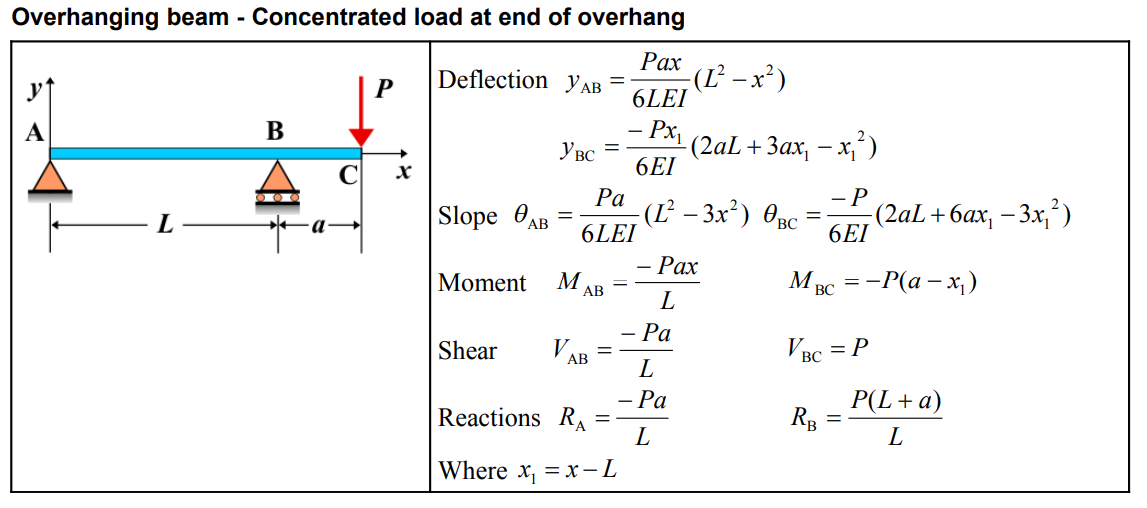Overhanging beam - Concentrated load at end of overhang Calculator

Overhanging Beam - Concentrated Load at End of Overhang
An overhanging beam is a beam that is supported at two points, with one end extending beyond its support, creating an overhang. When a concentrated load is applied at the free end of the overhang, it generates internal forces and deformations in the beam. The load creates bending moments, shear forces, and deflections that are specific to this loading configuration, with a significant effect at the free end where the load is applied.
Key Concepts
- Overhanging Beam: A beam that has one or both ends extending beyond its supports, leaving part of the beam unsupported.
- Concentrated Load: A single load applied at a specific point on the beam. In this case, the load is applied at the free end of the overhang, farthest from the supports.
- Shear Force: The shear force in the beam is greatest at the support closest to the free end and decreases toward the other support. At the free end, the shear force will be equal to the applied concentrated load.
- Bending Moment: The bending moment is maximum at the support closest to the overhanging free end. The moment increases as you move toward the free end and is influenced by the magnitude and position of the concentrated load.
- Deflection: The deflection is greatest at the free end of the overhang. The beam bends downward due to the applied load, and the deflection decreases toward the supports as the beam is constrained more at the supports.
Behavior of the Overhanging Beam
- Reaction Forces:
- The reaction forces at the supports can be determined by applying the equilibrium equations. The reactions include a vertical force at each support. The support closest to the free end will bear most of the load, while the other support will carry a reduced load.
- In addition to vertical reactions, the support closest to the free end will also experience a reaction moment, which resists the bending caused by the concentrated load.
- Shear Force Diagram:
- The shear force diagram for an overhanging beam with a concentrated load at the free end shows a vertical jump at the free end equal to the magnitude of the load. The shear force is constant along the overhang and gradually decreases to zero as you move towards the other support.
- Shear force is positive near the fixed support and negative towards the free end. The shear force at the free end will be equal to the magnitude of the load applied at that point.
- Bending Moment Diagram:
- The bending moment diagram is greatest at the fixed support and decreases as you move towards the free end. The moment diagram is triangular, with the maximum bending moment occurring at the fixed support closest to the overhang.
- At the free end, the bending moment is zero because no moment is generated at the location of the concentrated load.
- Deflection: The maximum deflection occurs at the free end of the overhang. The deflection is influenced by the load magnitude, the length of the overhang, and the beam's material and cross-sectional properties. The deflection formula can be derived using beam theory, and the maximum deflection at the free end is given by: \[ \delta_{\text{max}} = \frac{P L^3}{3 E I} \] where \( P \) is the magnitude of the concentrated load, \( L \) is the length of the overhang, \( E \) is the modulus of elasticity, and \( I \) is the moment of inertia of the beam's cross-section.
Applications
- Structural Engineering: Overhanging beams are commonly used in situations where part of the structure needs to extend beyond a support, such as in balconies, bridges, and extended roofs.
- Construction: Overhanging beams are used in building construction for cantilevered sections or for supporting elements that extend beyond the primary structure, such as protruding building sections or overhangs.
- Mechanical Systems: This type of loading is also seen in mechanical systems, such as crane booms or conveyor systems, where parts of the structure are required to extend out from the support structure and bear concentrated loads at the end.
Formula

| Category | Formula |
|---|---|
| Deflection \( y_{AB} \) | \[ y_{AB} = \frac{Pax}{6LEI} \left( L^2 - x^2 \right) \] |
| Deflection \( y_{BC} \) | \[ y_{BC} = \frac{-Px_1}{6EI} \left( 2aL + 3ax_1 - x_1^2 \right) \] |
| Slope \( \theta_{AB} \) | \[ \theta_{AB} = \frac{Pa}{6LEI} \left( L^2 - 3x^2 \right) \] |
| Slope \( \theta_{BC} \) | \[ \theta_{BC} = \frac{-P}{6EI} \left( 2aL + 6ax_1 - 3x_1^2 \right) \] |
| Moment \( M_{AB} \) | \[ M_{AB} = \frac{-Pax}{L} \] |
| Moment \( M_{BC} \) | \[ M_{BC} = -P \left( a - x_1 \right) \] |
| Shear \( V_{AB} \) | \[ V_{AB} = \frac{-Pa}{L} \] |
| Shear \( V_{BC} \) | \[ V_{BC} = P \] |
| Reactions \( R_A \), \( R_B \) | \[ R_A = \frac{-Pa}{L}, \quad R_B = \frac{P(L+a)}{L} \] |
| Where \( x_1 \) | \[ x_1 = x - L \] |
Definitions
| Symbol | Physical quantity | Units |
|---|---|---|
| E·I | Flexural rigidity | N·m², Pa·m⁴ |
| y | Deflection or deformation | m |
| θ | Slope, Angle of rotation | - |
| x | Distance from support (origin) | m |
| L | Length of beam (without overhang) | m |
| M | Moment, Bending moment, Couple moment applied | N·m |
| P | Concentrated load, Point load, Concentrated force | N |
| w | Distributed load, Load per unit length | N/m |
| R | Reaction load, reaction force | N |
| V | Shear force, shear | N |
 Home
Home Back
Back